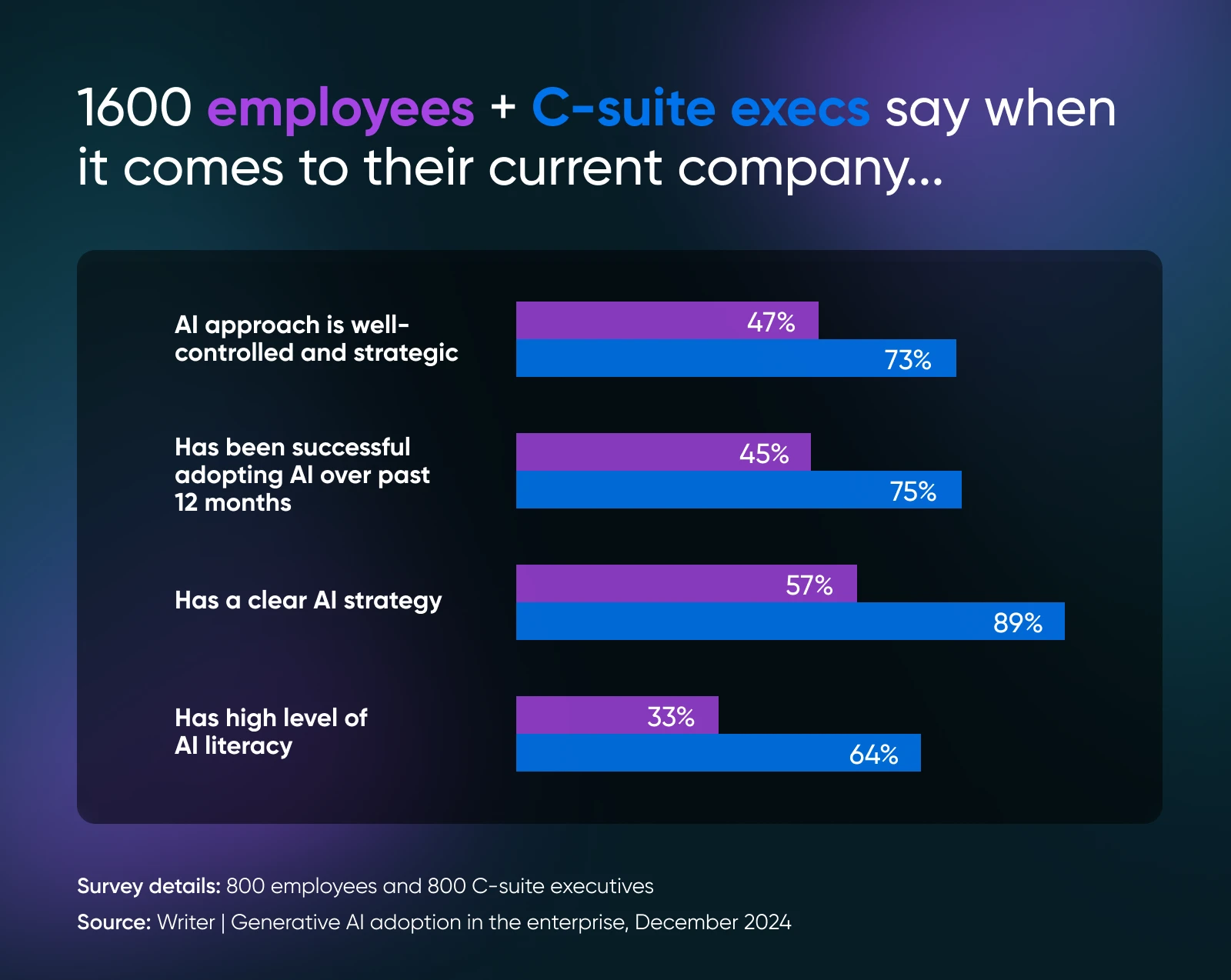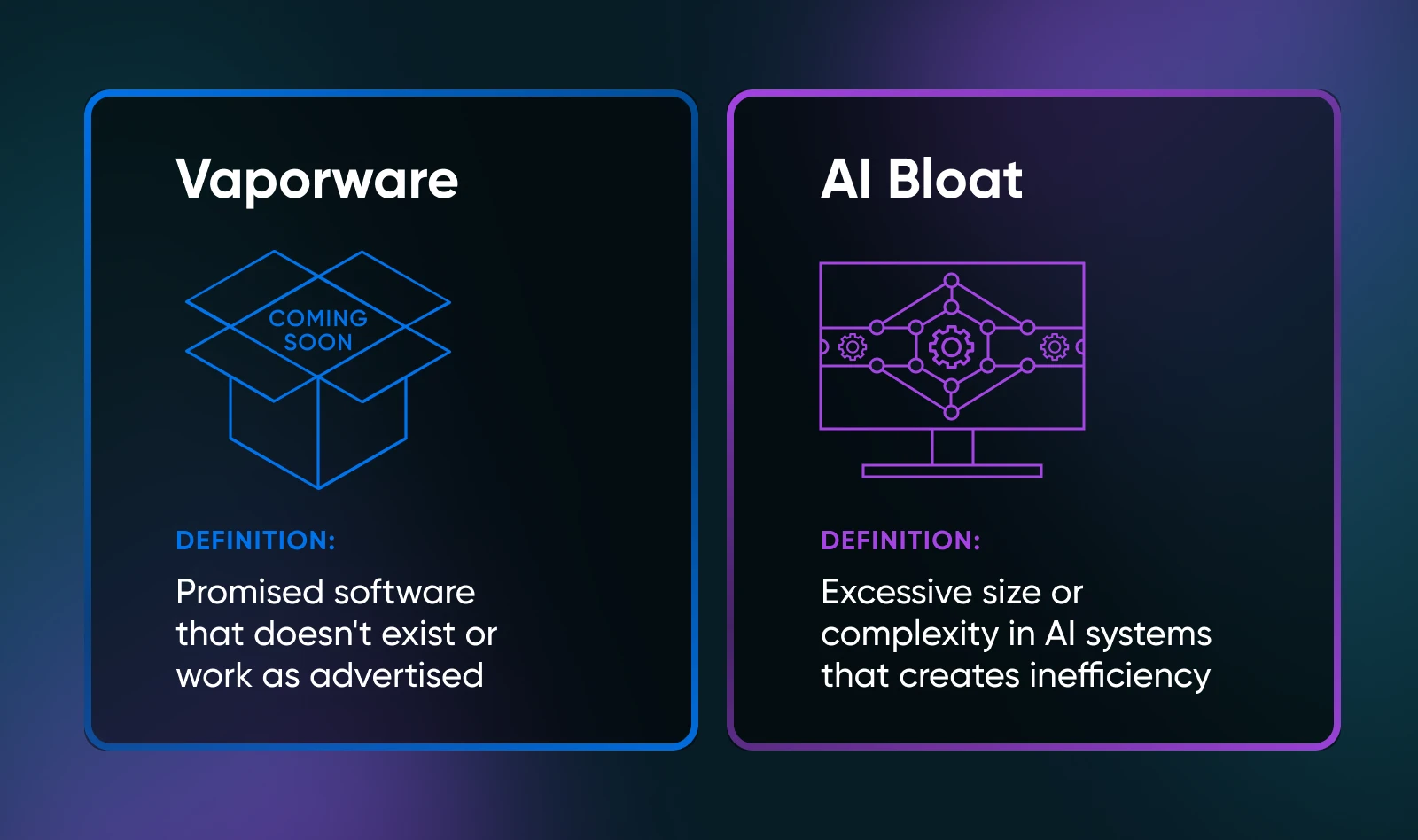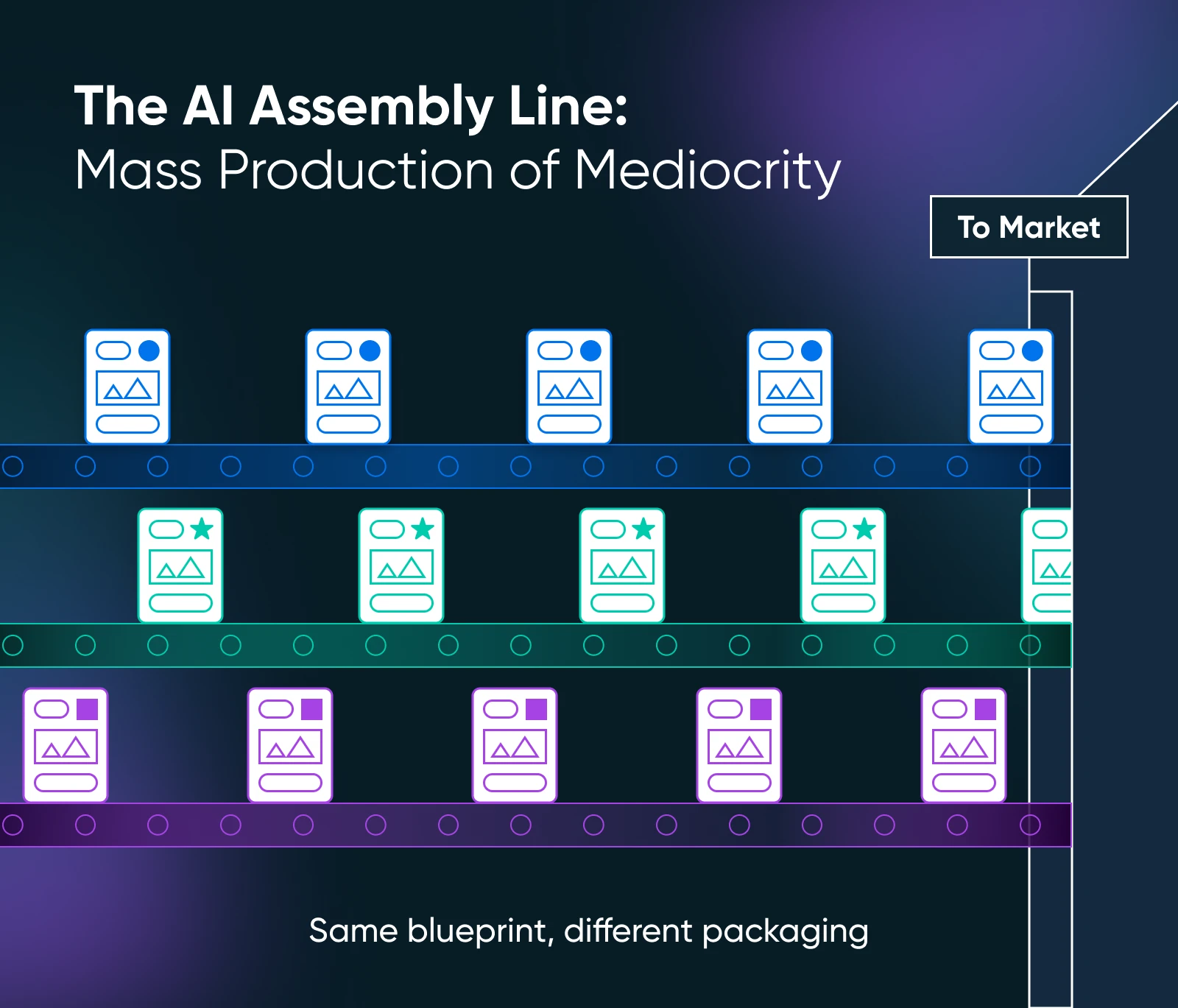This 12 months’s hottest SaaS pitch is beginning to sound eerily acquainted:
“Our AI-powered platform slashes busywork so you’ll be able to concentrate on what actually issues.”
Scroll Product Hunt on any random Tuesday and also you’ll see that sentence — give or take a buzzword or three — pasted onto dozens of shiny touchdown pages. And traders are taking the bait. Enterprise capitalists injected $100 billion into AI-related startups in 2024 alone, and generative AI specialists nabbed $56 billion of that throughout simply 885 offers.
In the event you’ve truly test-driven many of those instruments, you recognize the soiled secret behind the polished elevator pitches: most are simply shiny wrappers across the similar public API, providing indistinguishable options at inflated subscription costs.
As an alternative of a productiveness growth, we’re getting AI bloat: a swelling stack of “sensible” apps that promise gold however ship pyrite, the “idiot’s gold” that tricked many a prospector searching for fortune.
So, as all of us navigate the claim-staked valley of AI, we have to acknowledge many instruments for what they’re: copy-paste merchandise. We additionally want to higher perceive how the race to mediocrity hurts actual companies, and, most significantly, methods to pan for the few nuggets which can be value our time (and finances).
Able to separate idiot’s gold from the actual deal? Whether or not you handle a five-product Shopify retailer or wrangle 500 seats of enterprise CRM, the sifting course of is identical. Saddle up and let’s navigate this Wild West collectively.
It’s tempting to suppose the app retailer is stuffed with near-identical AI merchandise as a result of founders misinterpret the market. The reality is less complicated: the system incentivizes sameness.
Low Boundaries, Low-cost Constructing Blocks
Nearly anybody can spin up an AI resume author in a weekend. Right here’s all they should do:
- Seize a key to OpenAI or Anthropic’s API (20 minutes).
- Drag-and-drop a no-code frontend in Bubble, WeWeb, or FlutterFlow (2 hours).
- Model the dashboard with a $149 Tailwind UI equipment (half-hour).
- Stripe join a $49/month subscription tier (half-hour).
- Launch on Product Hunt Monday morning.
When the uncooked substances are that low cost and the recipe that repeatable, the variety of look-alike dishes on the buffet is sure to blow up. Plus, all the prevailing apps and instruments which can be including AI options (whether or not vital or not).
Capital Floodgates Are Broad Open
Traders see the low price of entry and dash in. International enterprise funding for AI-related startups broke $100 billion in 2024, which was an 80% leap over 2023. Practically a 3rd of these {dollars} went to foundation-model corporations, the identical engines that weekend warriors sew into their facet tasks. The result’s a layered pyramid of cash: massive rounds for mannequin builders on the base and 1000’s of level apps perched precariously on prime.
The Company FOMO Flywheel
Now, on prime of that, add patrons who’re afraid of getting left behind. A December 2024 survey of 800 C-suite leaders discovered that 94% of them had been dissatisfied with their present AI stack, however 59% admitted to “actively wanting” for jobs with corporations they thought of “extra progressive with generative AI.”

One attainable strategy to interpret these survey outcomes: executives know their AI instruments are broadly disappointing, however they’re nonetheless prepared to throw time, effort, and finances at them to keep away from wanting caught in 2023.
On the different finish of the spectrum, AI adoption amongst U.S. small companies has jumped 41% in 2025, in line with a brand new survey. The outcomes additionally confirmed that small companies typically undertake AI instruments with no formal vetting course of in any respect, displaying that SMBs are additionally feeling the AI hype, however with even fewer guardrails.
The Hidden Prices of AI Bloat
AI bloat is the swelling layer of look-alike, dashboard-heavy instruments that inflate price and complexity sooner than they ship outcome-changing outcomes.
Founders and traders have began utilizing this phrase, too. As Paddle founder Christian Owens advised HSBC Innovation Banking, “Founders must pay shut consideration to how clients are literally adopting and utilizing AI merchandise — the danger of ‘AI bloat’ is actual.”
What Owens meant is that clients undertake overlapping options sooner than they see actual worth. For instance, your seventeenth “AI assembly assistant” that data Zoom, spits out a abstract, and emails you a PDF you’ll by no means open.
It’s not vaporware; it really works —simply not in a approach that modifications your Tuesday.

However AI bloat comes with hidden prices, and never simply when the invoice arrives for the subscriptions for all these instruments. Right here’s the way it chips away at time, cash, and organizational belief:
- Time: Digital employees now change between apps almost 1,200 instances every single day, dropping about 5 workweeks a 12 months simply re-orienting themselves amid near-constant context switching. Each new “sensible” widget provides yet one more login display screen, onboarding video, and browser tab. Multiply that by a whole crew and the promise of “instantaneous productiveness” simply turns into extra busywork.
- Cash: License waste is skyrocketing. Zylo’s 2025 SaaS Administration Index pegs common annual spend at $49 million for the mid-enterprise, with 275 apps in play (and spend now rising sooner than app rely). Separate analysis exhibits that half of companies waste greater than 10% of their software program finances, and the common firm flushes about $18 million a 12 months on unused SaaS licenses.
- Belief: A Boston Consulting Group survey discovered that 74% of corporations nonetheless wrestle to show AI pilots into scaled, value-generating applications. When executives watch slick demos however see no observe by, confidence plummets, and inner champions lose political capital. That erodes the very assist you’ll want for genuinely useful improvements in a while.
The Race To Mediocrity
Why is that this all so problematic?
Effectively, think about 10,000 startups mining the identical vein of ore. High quality doesn’t climb; it converges. That’s precisely what’s occurring with AI-first SaaS, and the implications are already displaying up in each codebases and creativity.
Clone-of-a-Clone Syndrome
Take a fast scroll by Product Hunt. Does it appear to be a lot of the launches are “[Insert-Your-Niche-Here]GPT”?
The Shopify App Retailer now lists greater than 3,700 outcomes whenever you seek for “AI product description generator.” Lots of them admit within the title or description that they’re constructed on a ChatGPT API, making who is aware of what number of of them successfully the very same app.
That isn’t simply anecdotal. Crunchbase information for the 885 generative AI offers that closed in 2024 exhibits many instruments with overlapping roadmaps. Even Forbes Tech Council has warned that normalizing “ok” AI actively situations clients to just accept mediocre outcomes.
We are able to all work on combatting this by getting higher at recognizing it within the wild: search for comparable pricing pages, equivalent template libraries, and options that ship inside days of one another as a result of everybody’s pulling from the identical open-source repo.

Creativity on Autopilot
The sameness isn’t restricted to product design. It additionally bleeds into what customers create utilizing AI instruments.
There are numerous examples of this, with extra rising on a regular basis as AI instruments turn out to be extra prevalent and broadly used.
- An MIT examine of scholars’ EEGs confirmed that individuals who drafted essays with ChatGPT had the bottom mind engagement and originality scores of any group studied.
- A Cornell CHI 2025 paper posits that AI options “homogenize writing towards Western kinds and diminish cultural nuance.”
- A current TIME essay claims that AI “thrives when our demand for mediocrity is excessive” and nudges tradition towards a lowest widespread denominator.
When the tooling itself pulls everybody towards the center, originality turns into a scarce — and subsequently extra useful — commodity. How that can play out stays to be seen, however it’s not wanting good.
Shiny UI, Shallow Core
So why can we nonetheless purchase in? As a result of people are naturally drawn to shiny issues, and the gloss is terrific.
A graphic-heavy hero video can persuade us {that a} product is deeply built-in. An onboarding wizard can masks that the underlying logic is a single immediate. Weekly roadmap tweets can promise depth that merely by no means materializes.
Builders know these tips. They know design is cheaper than pioneering new fashions or constructing messy integrations. So the finances tilts towards polish, not substance. And when every thing appears to be like wonderful on the floor, issues keep hidden (ish), however every underperforming software makes stakeholders much less prepared to threat something actually daring later.
Recognizing (and Avoiding) AI Bloat: A Sensible Guidelines
What are you able to do to fight AI bloat and mediocre instruments?
Subsequent time you’re contemplating an AI software, pull up this guidelines. Particularly if a software or demo appears too good to be true, run it by the filters under — most AI instruments which can be all (and even largely) hype will stumble by step 2 or 3, which implies you’ll be able to keep away from them and save money and time.
The few instruments that do go are the actual gold nuggets which can be definitely worth the funding.
| What To Ask | Why It’s Vital | Fast Check |
| Which workflow bottleneck does this repair for me? | Instruments that may’t articulate a pains-to-gains story are often characteristic fishing. | Clarify the use case to a colleague in a single sentence. In the event you can’t do that, stroll away. |
| Do you employ proprietary fashions or distinctive information sources? | A Canva-level UI on prime of generic GPT-4 is never truly higher than simply opening ChatGPT in your individual tab. | Search for white papers, benchmark dashboards, or open technical docs. |
| Are you able to present me ROI benchmarks, not simply checklist costs? | Bloat hides in hidden seats, per-output charges, and overages. | Ask for a sandbox or a pilot tied to a measurable KPI earlier than signing a contract. |
| How cleanly does this plug into my present stack? | Export-to-PDF is just not an integration. Native CMS/CRM plugins stop copy-paste purgatory. | For WordPress customers, does it ship as a vetted plugin or require integration duct tape? Search for not less than 1,000 energetic installs —something much less is a reliability gamble. |
| The place can I see your changelog and neighborhood? | Vaporware fades. Energetic GitHub repos and public roadmaps sign endurance. | Scan launch notes. Month-to-month drops are a great sign {that a} software has momentum. |
| Who owns the information, and might I self-host if wanted? | Information sovereignty legal guidelines get stricter each quarter. Instruments that allow you to select internet hosting or bring-your-own-key are future-proof. | In the event you want on-prem or region-restricted internet hosting, take a look at our Native AI Internet hosting information for a primer on self-managed choices. |
Professional-Utility, Not Anti-AI
Whereas we’re firmly in opposition to the flood of gimmicky, “AI-for-AI’s-sake” instruments, let’s be clear: we’re not waving torches and pitchforks at each robotic we see.
We fortunately undertake new tech when it truly clears the guidelines above. Exhibit A: Liftoff AI Web site Builder.
For a lot of small enterprise homeowners, the largest hurdle isn’t internet hosting. It’s design paralysis. So we requested: Can AI assist remove first draft dread with out locking individuals right into a walled backyard?
The Liftoff AI Web site Builder:
- Addresses one clear ache level: “I want an expert WordPress website, yesterday.”
- Doesn’t simply spit out static HTML: It scaffolds a completely editable WordPress set up in beneath 60 seconds.
- Works along with your present website infrastructure: As a result of it’s native WordPress, you retain each acquainted plugin, theme, and workflow.
- Has a sustainable roadmap: DreamHost has been transport WordPress instruments for 25 years, and Liftoff is free with any Managed WordPress plan.
- Provides you governance: Your content material lives on your internet hosting account, not in a black field SaaS.
Liftoff isn’t the one software that meets our utility bar, however it’s a concrete proof-of-concept: AI might be transformative when it erases friction whereas respecting possession and open requirements.
If the subsequent seemingly shiny product you take a look at can’t match that ethos, you’ve received your reply: it’s idiot’s gold.
The AI gold rush isn’t slowing down; the pitches are simply getting louder. A few of what’s mined will truly be priceless, however it’s as much as all of us to have the ability to inform actual gold from the pretend stuff.
Keep curious, keep skeptical, and hold your tech stack lean sufficient to dash when the actual breakthroughs arrive.
Did you take pleasure in this text?

